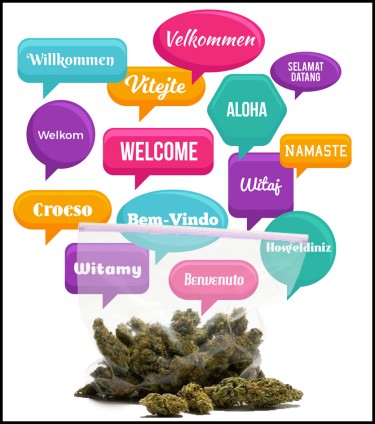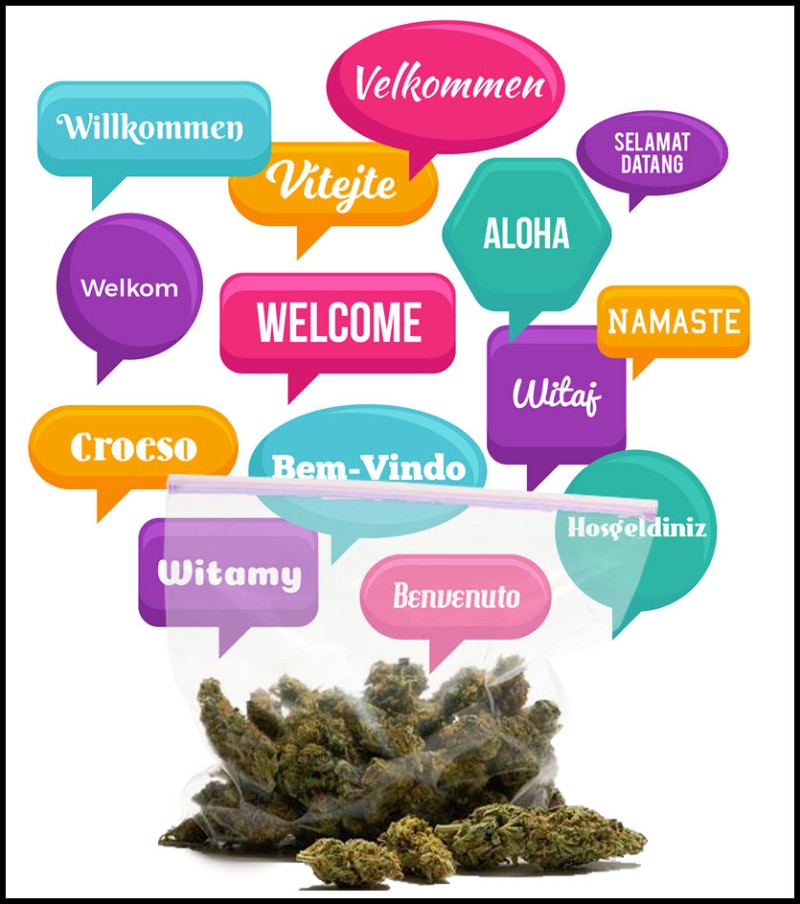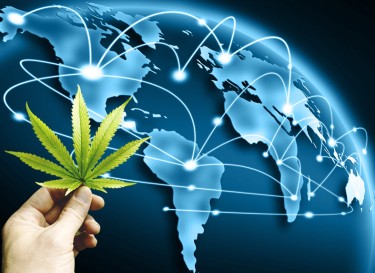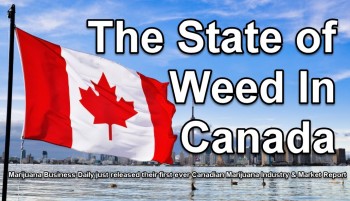
An International Guide to Getting Weed in the Top 5 Languages
“Nǐ yǒu dàmá “some Dank”, por favor!
When you’re an international man of misty-weed, it’s a good idea to learn how to get cannabis in all different flavors. And by “flavors”, I’m talking about languages.
It recent dawned on me that I am able to ask for cannabis in 2 of the top 5 most spoken languages in the world (Spanish and English). While I’m fluent in both of these, I figured that it would be in my best interest to learn how to get the sticky icky in the remaining 3 top spoken languages in the world (Mandarin, Hindi, and Arabic)
At first, I figured, “this will be a fun article to write”, but as I made artificial intelligence bots research my out-of-the-box prompts - it dawned on me that I was doing something much bigger. I was actually doing a really poorly constructed case study on cannabis and different regions of the world specifically relating to language.
This pioneering research actually provided some crazy insights and allowed me to come up with some interesting questions as a result. This article has several purposes:
-
To educate you on how to get weed in any country in the world. In all likeliness, irrespective of where you find yourself in the world - knowing the phrases in this article will help you get weed (or land you in jail if you’re going to be shouting it in places you’re not supposed to). [more on that later]
-
To analyze regional attitudes towards cannabis and provide proper warning to stoners in those regions. You don’t want to be the next person to hang in Singapore because you wanted to buy weed on the streets.
-
Ask some questions that will help us expand our understanding of our collective relationship with cannabis.
So without any further delay, let’s get to it!
Regional Guide to Cannabis Based on Language
Let’s begin with the basics. While this list won’t dive into all of the slangs of weed for the different language, it will certainly put you in the general ballpark. Some of the terms might be “outdated” like asking for “the reefers” from a dealer with a vape stuck on their bottom lip.
Nonetheless, if you utter these words in these languages - you’ll be one step closer to weed.
Mandarin Chinese:
Interesting facts: Mandarin Chinese is a tonal language, meaning that the meaning of a word can change depending on the tone in which it is pronounced. Mandarin has four tones and a neutral tone, adding complexity to the language.
Chinese characters are made up of radicals, which are smaller components that contribute to the meaning of the character. There are over 200 radicals, and recognizing them can aid in understanding and learning Chinese characters.
Total Population: Approximately 1.41 billion people.
Regions: Mainland China, Taiwan, Singapore, Malaysia.
Cannabis Consumption: It is difficult to obtain precise statistics on cannabis consumption in China due to its illegal status. However, it is generally considered to be low, with traditional attitudes towards drug use.
Cannabis/Weed: 大麻 (dàmá)
Slang terms: 麻古 (mágǔ), 嗨草 (hāicǎo), 草头 (cǎotóu), 烟草 (yāncǎo), 绿叶 (lǜyè)
How to ask for it on the streets: "你有大麻吗?" (Nǐ yǒu dàmá ma?) - "Do you have cannabis?"
"Where can I find weed?" - "我在哪里可以找到大麻?" (Wǒ zài nǎlǐ kěyǐ zhǎodào dàmá?)
"How much does it cost?" - "多少钱?" (Duōshǎo qián?)
Spanish:
Interesting facts: Spanish has a unique punctuation mark called the "¡exclamation mark inverted!" or "¡signo de apertura de exclamación!" It is placed at the beginning of an exclamatory sentence to indicate that the sentence is exclaimed.
Spanish has a rich tradition of "dichos" or proverbs. These short, memorable sayings reflect the wisdom, values, and cultural heritage of Spanish-speaking communities.
Total Population: Approximately 480 million people.
Regions: Spain, Mexico, Colombia, Argentina, Peru, Venezuela, Chile, Ecuador, Guatemala, Cuba, and many others.
Cannabis Consumption: Cannabis consumption varies across Spanish-speaking regions. Countries like Spain, Mexico, and Colombia have reported higher rates of cannabis use compared to others, while some countries have more stringent drug policies.
Cannabis/Weed: Cannabis/Marihuana/Mota
Slang terms: Hierba, Porro, María, Ganja, Faso, Churro, Peta, Canuto, Cogollo, Verde
How to ask for it on the streets: "¿Tienes mota?" - "Do you have marijuana?"
"Where can I find weed?" - "¿Dónde puedo encontrar marihuana?"
"How much does it cost?" - "¿Cuánto cuesta?"
English:
Interesting facts: English is known for its vast vocabulary, and it is estimated that English has more words than any other language. The Oxford English Dictionary contains over 170,000 words in current use.
English is heavily influenced by other languages, with approximately 60% of its vocabulary derived from Latin, French, and Germanic languages. This linguistic diversity reflects the historical influences on the English language.
Total Population: Approximately 1.27 billion people speak English as either a first, second, or foreign language.
Regions: United States, United Kingdom, Canada, Australia, New Zealand, India, South Africa, and various other countries.
Cannabis Consumption: Cannabis consumption varies across English-speaking regions due to differing legal frameworks. Countries like the United States and Canada have seen significant increases in cannabis use after legalization.
Cannabis/Weed: Cannabis/Marijuana/Weed/Pot
Slang terms: Bud, Grass, Reefer, Ganja, Herb, Mary Jane, Pot, Dank, Green, Chronic
How to ask for it on the streets: "Do you have weed/marijuana?"
"Where can I find weed?" - "Where can I find weed/marijuana?"
"How much does it cost?" - "How much does it cost?"
[YES, I did this!]
Hindi:
Interesting Facts: Hindi is written in the Devanagari script, which is phonetic and syllable-based. Unlike alphabetic scripts, each character in Devanagari represents a syllable rather than an individual sound, making it visually unique.
Hindi uses postpositions instead of prepositions. Postpositions are added after nouns to indicate relationships, such as "ke paas" meaning "near" or "with" in English.
Total Population: Approximately 341 million people speak Hindi as their native language, mainly in India.
Regions: Primarily in India, with significant Hindi-speaking populations in Nepal, Mauritius, Fiji, and several other countries.
Cannabis Consumption: Cannabis consumption in India is relatively common, especially in certain regions where it has cultural and religious significance. However, the exact number of cannabis consumers is difficult to estimate due to its illegal status in most parts of the country.
Cannabis/Weed: भांग (bhāṅg)
Slang terms: गाँजा (gānjā), चरस (charas), माल (māl), पुलिस वाली (police wālī), महाकाल (mahākāl)
How to ask for it on the streets: "भांग/गाँजा/माल है क्या?" (Bhāṅg/gānjā/māl hai kya?) - "Do you have bhāṅg/gānjā/māl?"
Where can I find weed?" - "मैं भांग कहाँ मिलेगी?" (Main bhāṅg kahāṁ milegī?)
"How much does it cost?" - "यह कितने का है?" (Yeh kitne kā hai?)
"Where can I find weed?" - "मैं भांग कहाँ मिलेगी?" (Main bhāṅg kahāṁ milegī?)
"How much does it cost?" - "यह कितने का है?" (Yeh kitne kā hai?)
Arabic:
Interesting Facts: Arabic is written from right to left, and its script is called "Arabic script" or "alif-ba." It is a cursive script, and the shape of letters can change depending on their position within a word.
Arabic has a unique linguistic feature called "diglossia," which means that there are two forms of the language: Classical Arabic and the spoken vernacular dialects. Classical Arabic is used for formal writing and religious texts, while different dialects are spoken in daily life.
Total Population: Approximately 310 million people speak Arabic as their first language.
Regions: Arabic-speaking countries in the Middle East and North Africa, including Egypt, Saudi Arabia, Iraq, Morocco, Algeria, United Arab Emirates, and others.
Cannabis Consumption: Cannabis consumption in Arabic-speaking countries is generally low due to strict drug laws and conservative cultural attitudes towards drug use. However, it is important to note that there may be variations and differences among individual countries within the Arabic-speaking region.
Cannabis/Weed: حشيش (hashish)
Slang terms: زطلة (zatla), حشيشة (hashisha), العشبة (al-ashba), الدخان (ad-dokhan), البت (al-bat)
How to ask for it on the streets: "عندك حشيش؟" (ʿindak hashish?) - "Do you have hashish?"
"Where can I find weed?" - "أين يمكنني العثور على حشيش؟" (Ayna yumkinuni al'uthur ealaa hashish?)
"How much does it cost?" - "بكم ثمنها؟" (Bikam thamanuha?)
Regional Attitudes in Relation to Cannabis Based on Language
Now that you have your crash course in how to get weed in virtually the whole world. Let’s take a look at “acceptance” of cannabis based on these regions. What I did with all of this information was to ask my artificial intelligence bot to make a general guesstimate about the “tolerance to cannabis” based on each language and the countries that have a common bond.
I created three sub-categories to classify these “temperatures”:
-
420-Phobic - We’re not using the interpretation of “fear” when using the word Phobia, but rather in the sense of a “strong aversion to”. One could argue that the aversion stems from fear of mass consumption in these regions, however, that would be mere speculation.
-
420-neutral - This refers to places that don’t really care too much about cannabis. Perhaps it’s “illegal” but it’s a low priority” or perhaps they have some decriminalized scheme within the region.
-
420-friendly - Full on legalization, talks of legalization, cannabis commerce… you can buy weed in a dispensary.
With these three classifications, I ranked the languages accordingly going from “Most 420-friendly” to “Most 420-phobic”
English: Varies across regions (420-Friendly to 420-Neutral)
-
Countries like Canada, certain states in the United States, and some European countries have implemented more lenient cannabis laws and are more accepting of its recreational and medicinal use.
-
This is not a universal stance, as other English-speaking regions may still maintain stricter drug laws and conservative attitudes towards cannabis.
Spanish: Varies across regions (420-Friendly to 420-Neutral)
-
Countries like Spain, Uruguay, and certain regions in Mexico and South America have adopted more progressive cannabis policies and have more accepting attitudes towards its use.
-
However, there are still Spanish-speaking regions with stricter drug laws and more conservative views on cannabis.
Hindi: Varies across regions (420-Neutral to 420-Friendly)
-
Certain regions in India, such as parts of Uttarakhand and Himachal Pradesh, have more tolerant attitudes and legal provisions for cannabis use in religious ceremonies.
-
However, overall drug laws in India are strict, and cannabis is generally prohibited. The societal attitudes towards cannabis can also vary across different communities and regions in the country.
Mandarin Chinese: 420-Phobic
-
China has strict drug laws, including for cannabis.
-
Cannabis use is generally stigmatized and viewed as socially unacceptable.
-
Traditional attitudes towards drug use emphasize prohibition.
Arabic: 420-Phobic
-
Arabic-speaking countries generally have strict drug laws, including for cannabis.
-
Conservative cultural and religious attitudes towards drug use contribute to a generally negative perception of cannabis.
-
Cannabis use is stigmatized, and the majority of countries in the region prohibit its use and possession.
Some Important Questions:
Now, as we take a look at all of this information, I can’t help but wonder. I brainstormed a few questions, maybe some of you can provide insight;
-
How does the historical use of cannabis in religious ceremonies influence the perception and acceptance of cannabis in regions where the language is spoken?
-
In regions with more accepting attitudes towards cannabis, what cultural factors contribute to this acceptance and how are these factors reflected in the language?
-
What role does language play in shaping the stigma or acceptance of cannabis within a specific cultural context?
-
Can the historical and etymological analysis of cannabis-related words in these languages provide insights into the cultural significance and perception of cannabis?
-
Are there any unique linguistic expressions or idioms related to cannabis in these languages that reflect cultural attitudes or experiences?
-
How does the presence or absence of slang terms for cannabis in a language reflect the level of acceptance or prohibition within a society?
-
Do regional dialects or variations within a language exhibit different linguistic expressions or attitudes towards cannabis?
-
What impact does the globalization of cannabis-related discourse have on the linguistic and cultural aspects of regions where the language is spoken?
-
Are there any notable literary works or traditional songs in these languages that depict or discuss cannabis, and what do these artistic representations reveal about cultural attitudes?
-
How do public health campaigns or anti-drug initiatives in regions where the language is spoken shape the discourse surrounding cannabis and impact language usage?
-
Does the portrayal of cannabis in popular media, such as movies or music, influence public perception, language usage, and cultural attitudes towards cannabis?
-
What role does cultural heritage, including traditional medicinal practices, play in shaping the acceptance or prohibition of cannabis in these regions?
-
How do generational differences influence the perception and acceptance of cannabis, and how is this reflected in the language used by different age groups?
-
Are there any linguistic taboos or euphemisms related to cannabis in these languages, and how do these reflect societal attitudes or legal restrictions?
-
How have government policies and legislative changes regarding cannabis impacted the language and cultural practices in regions where the language is spoken?
-
How does the presence of indigenous languages within these regions contribute to the overall understanding of cannabis and its cultural significance?
-
What can the study of cannabis-related language and cultural heritage reveal about the potential for shifts in attitudes, policy changes, or evolving societal norms regarding cannabis use in these regions?
The Sticky Bottom Line
Of course, I don’t expect anyone to actually answer these, however, it is my hope that at least one of these questions sparks your creativity. The fact of the matter is that language dictates our reality and the words and expressions we use shape our behavior.
Understanding the importance of language and how it impacts the behavior of a specific region is absolutely critical in terms of understanding our relationship to the plant from the perspective of the human “species”.
Sure, this won’t help us understand the physiological impacts of the plant on the individual, but it does give us insight on the cultural importance of the plant and how we view it based on the region we’re born.
Most importantly however, you now know how to get weed no matter where you are. You are welcome!






